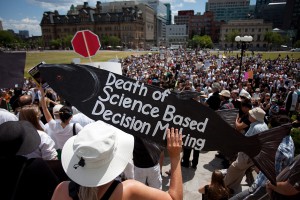Peace and Environment News, September–October 2012
by Mike Buckthought
On July 10, 2012, hundreds of Canadian researchers and concerned citizens marched to Parliament Hill to protest the government’s unprecedented war on science. Protesters wore lab coats, or dressed in black to mourn the “death of evidence.”At the front of a mock funeral procession, a black-robed Grim Reaper carried a scythe, symbolizing the budget cuts that have killed many research projects. Following behind the Grim Reaper, pallbearers carried a coal black coffin.
Many protesters carried placards with messages mourning the loss of important environmental research programs. People highlighted the federal government’s decision to cut funding for the world-renowned Experimental Lakes Area (ELA). “It doesn’t matter how much water you have if it’s all polluted. Save ELA,” read one placard.
The ELA is just one example of a research program that has been cut. Recent government decisions have seriously undermined our ability to develop sound environmental policies based on scientific evidence. “Canadians want science-based policy, not ideology,” said one placard.
The procession continued down Wellington Street, a river of white and black leading to Parliament Hill. Along the way, people chanted “No science, no evidence, no truth, no democracy.” A rally on the Hill featured speakers from the scientific community and non-governmental organizations such as the Council of Canadians.
“We are all here today to commemorate the untimely death of evidence in Canada. After a long battle with the current federal government, evidence has suffered its final blow,” said rally organizer Katie Gibbs.
“Between the sweeping cuts to federal science programs, the legislation changes that we saw in Bill C‑38, and the muzzling of scientists, the injuries to evidence have just been overwhelming.”
The speakers delivered “eulogies” criticizing recent actions of the federal government.
“The risks of living in a fantasy world at this point in history are very grave,” said Dr. Arme Moores, professor of biodiversity at Simon Fraser University.
Moores said the government appears to be “retreating from reality” at a time when there are serious threats to our water, food and the environment. “When countries engage in fantasy, it’s called state propaganda,” he said.
Another speaker criticized the government’s attempts to silence scientists, and recent changes to the Fisheries Act.
“The federal government has weakened national fisheries and environmental legislation, trivialized the relevance of scientific advice, and eliminated government scientific research of fundamental importance to the health of Canadians,” said Jeff Hutchings, a professor of biology at Dalhousie University.
“Freedom of expression is no longer a right enjoyed by Canadian government scientists,” he said. “When you inhibit the communication of science, you inhibit science. When you inhibit science, you inhibit the acquisition of knowledge.”
At a time when many species are threatened by climate change, industrial pollution and loss of habitat, it is essential to support environmental research. The death of evidence leads to the death of species.
Canadians will not be content to live in a country that turns its back on scientific research. Such an approach is dangerous, at a time when our survival is threatened by global warming. In future years, the Death of Evidence rally will no doubt be seen as a turning point. After years of budget cuts and the silencing of scientists, people are ready to speak out.
For photos, videos and background information about cuts to environmental research in Canada, visit the Death of Evidence website: www.deathofevidence.ca.
Mike Buckthought is a writer and environmental researcher based in Ottawa.
Published in the Peace and Environment News, Volume 27, Number 4, September–October 2012, page 1.
